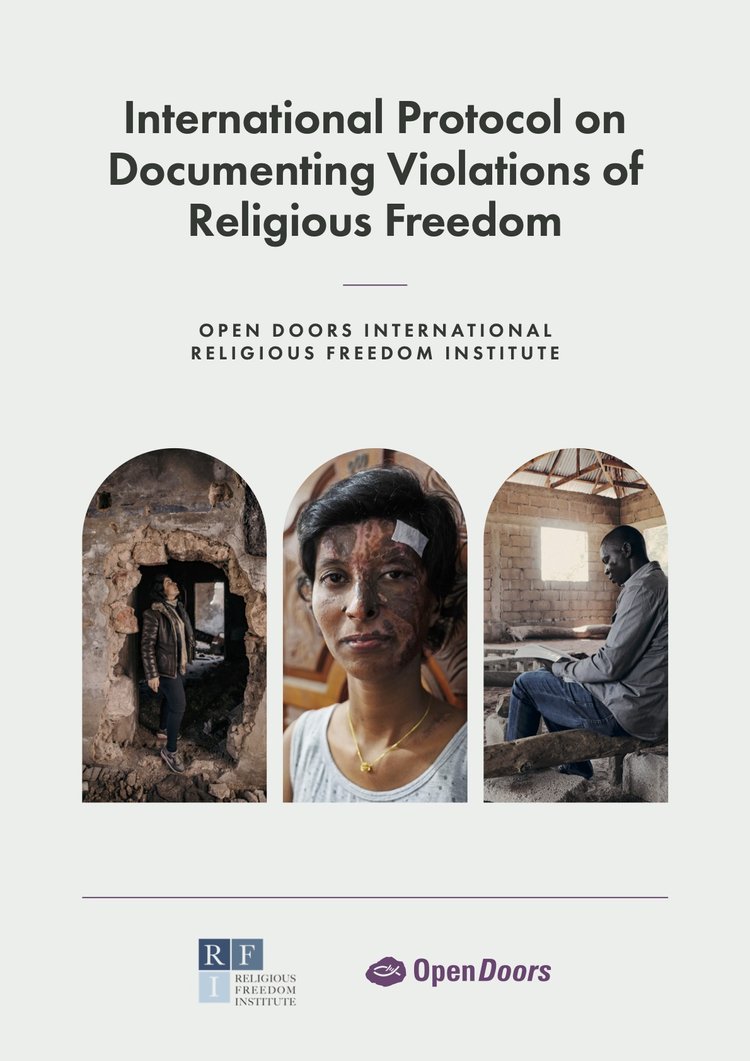PROTOCOL
International Protocol on Documenting Violations of Religious Freedom
ABOUT THE DOCUMENTATION PROTOCOL:

Crafted in response to requests from civil society partners who have suffered severe violations of their religious freedom, the protocol seeks to fill a gap by providing a thorough and accessible resource for human rights advocates, civil society organizations, and others looking for guidance on how to document serious violations of religious freedom in their local contexts.
The International Protocol On Documenting Violations Of Religious Freedom is a joint publication of Open Doors International (ODI) and the Religious Freedom Institute (RFI). Led by the Middle East divisions of ODI and RFI, the project was crafted with contributors including lawyers, human rights investigators, former diplomats, and religious freedom researchers.
It is designed as a tool for NGOs, lawyers, human rights activists as well as national and international institutions to provide an evidentiary standard and documentation of evidence that would be acceptable in most judicial or advocacy institutions, particularly at the international level.
The core of the protocol provides a set of guidelines detailing the best practices on how to document violations of religious freedom as per international standards, combined with an articulation of the right and its protected dimensions under international law.
LAUNCH EVENT:
GATHERING THE EVIDENCE OF PERSECUTION: THE IMPORTANCE OF DOCUMENTATION AND LAUNCH OF THE “INTERNATIONAL PROTOCOL ON DOCUMENTING VIOLATIONS OF RELIGIOUS FREEDOM”
With violations of religious freedom impacting individuals and communities across the globe, gathering and preserving evidence of violations is critical. For perpetrators to be held to account, for advocacy efforts to be launched, for the world to be made aware, reliable documentation is vital. This event brings together voices on the frontlines of protecting the fundamental right of religious freedom and holding to account those responsible for its violation and serves to launch the International Protocol On Documenting Violations Of Religious Freedom.
June 9, 2022 | 9:30 AM Eastern USA | 3:30 PM EET | 4:30 PM Arabian Standard Time
USING THE DOCUMENTATION PROTOCOL
The documentation protocol is an extensive resource for individuals and organizations leading monitoring or documentation efforts covering religious freedom violations. The protocol provides insight into key definitional questions about religious freedom violations and how these fit within various legal schemes. The protocol also provides practical resources for preparing for and conducting documentation and an overview of ways to utilize collected information.
To assist individuals and organizations in understanding and applying the protocol in context consultations and training (virtual or in-person) may be available. Contact us if you would like to learn more about the documentation protocol and how you can apply it within your context you can request a consultation.
TABLE OF CONTENTS
Part 1: Defining Religious Freedom
- Understanding Religious Freedom Within the International Human Rights Framework
- Protections and Interpretations of Religious Freedom in International Law
- Elements of Religious Freedom under International Human Rights Law
- Lawful Limitations on Religious Freedom
- Protecting the Religious Freedom of Groups at Risk
- The Intersection of Religious Freedom with Other Human Rights
Part 2: Monitoring and Documenting Violations of Religious Freedom
- Monitoring and Documentation
- Documenting Violations of Religious Freedom — Key Principles of Documentation
- Stages of Documentation
Part 3: Using the Information Documented – Avenues for Advocacy
- Advocacy
- Reporting (Drafting a Report)
- Advocacy Avenues
- Judicial Avenues
Part 4: References
- Section 1: Defining Religious Freedom
- Section 2: Monitoring and Documenting Violations of Religious Freedom
- Section 3: Using the Information and Evidence Collected – Avenues for Advocacy
Part 5: Appendices
- Documentation plan – Elements to consider
- Risk Assessment
- Documentation folder templates/samples
- Legal Analysis
